Drawing of Tree With Feathers
Some points to keep in mind when drawing fur or feathers include the following:
- Observe closely the direction in which the fur or feathers grow and draw your shading lines to follow these directions.
- Fur and feathers look much more realistic when the shading lines are different lengths and sizes.
- Use curved shading lines to define the form of a bird or animal.
- Pay special attention to light and shadows, as well as texture, when shading fur or feathers.
Identifying the long and short of fur
The furry coats of animals can be straight, curly, soft, coarse, shiny, matte, spotted, or striped! Keep the following guidelines in mind when drawing either short or long fur:- To make fur look short, you draw short (mostly curved) hatching lines. Use long, curved hatching lines to create the illusion of long fur.
- Hatching is the perfect shading technique for rendering the texture of most types of fur.
- Bold, thick lines give the illusion of coarse fur, and gentle, thin lines help fur to look soft.
Short fur
In Figure 1, meet Shadow. Shadow's fur is short, soft, and shiny. She sheds enough fur in one month to make a spotted fur coat for a bald Chihuahua! 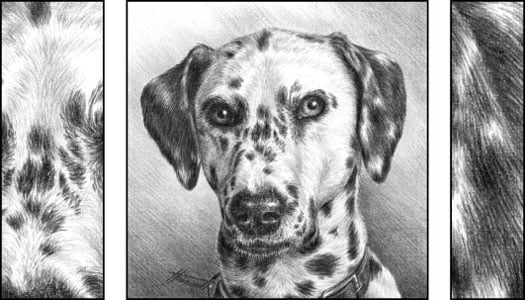
Look at how the shading of Shadow's short fur clearly defines the bone structure of her head and face. Observe the close-ups of the patterns of black spots on white fur, and white spots on black fur in Figure 1. The fur grows in many different directions. Look at all the different values, from white to medium, used to represent the light fur. A range of values from medium to black depicts the black fur.
In Figure 2, you see a combination of fur and feline facial features in a caricature of Riley. Have a look at how soft his fur looks and all the different directions in which it grows. Riley's fur is finer and softer than the fur of a Dalmatian. His eyes are drawn realistically, but a little artistic license was taken with his nose by making it more of a button shape. This gives the drawing a cartoon-like impression, almost as if he were a stuffed toy.
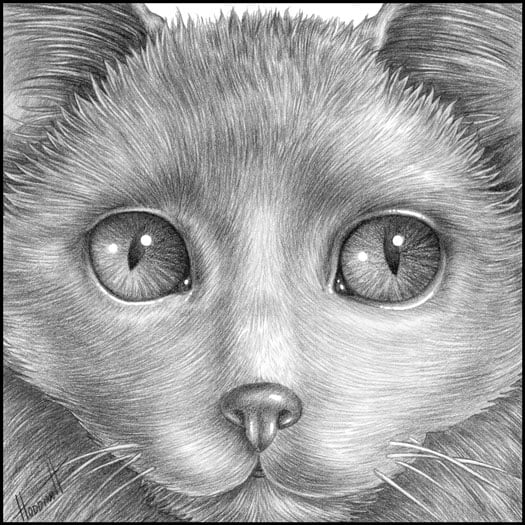
Long fur
Long fur tends to be somewhat more difficult to draw because the individual strands often curve in different directions and overlap one another.In Figure 3 you see Rosey, who now lives at the Rainbow Bridge. She had very soft, slightly wavy fur and looked most adorable when her fur was wild and messy.
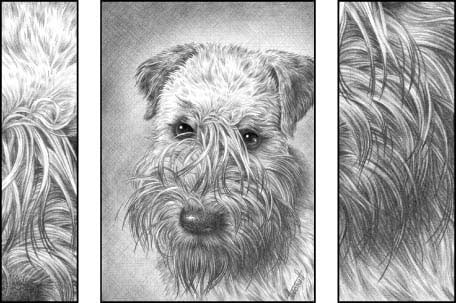
Long fur doesn't define the bone structure of an animal as well as short fur. But the contrasting shading of the light and shadow areas identifies the basic form of her head.
Drawing form beyond the furry texture
In this exercise, you draw the form of the leg and foot of a puppy with short fur. The same basic principles apply to drawing short fur on any part of an animal's body.1. Lightly sketch the three shapes you see in Figure 4.
The top shape is a section of the puppy's body, the longer one is his leg, and the horizontal oval shape at the bottom is his paw.
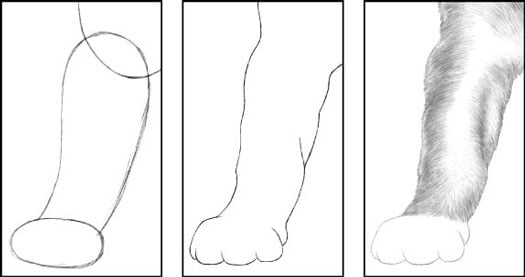
2. Use your kneaded eraser to lighten your sketch lines and draw a more detailed outline.
3. With your HB pencil, begin shading the values you see with hatching lines to represent the texture of fur.
Watch closely the direction in which the fur grows (see the third drawing in Figure 4). On the main part of the leg, it seems to grow downward in the center. As it gets closer to the edges of the leg, it curves outward at a downward angle to the edges of each side of the legs.
4. Use your 2B pencil to darken the shading in the shadow areas of the leg (see Figure 5).
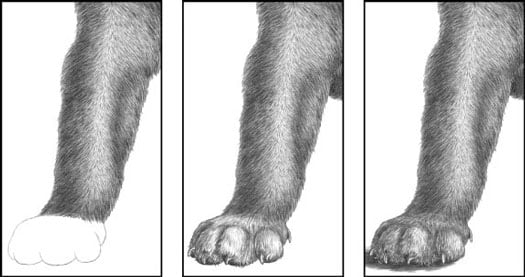
5. Add the light shading on the paw, and outline the toenails on the toes (see the second drawing in Figure 5).
6. Add a section of dark fur where the top of the leg meets the chest.
7. Use your 2B pencil to add the dark shading to his paw and to draw the shadow under his paw (as in the third drawing in Figure 5).
Letting your drawing soar with winged things
In Figure 6, have a look at a drawing of a generic feather. Understanding an individual feather's basic shape and construction allows you to draw the many feathers of a wing with increased accuracy. The wide end of the shaft (the long skinny thing in the center) of a feather is called a quill. It has a hollow center, and many years ago, people dipped quills into ink and used them as writing tools. 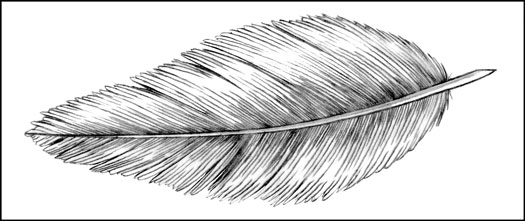
Wings come in a vast range of shapes and sizes, from the tiny delicate wings of a hummingbird to the magnificent strong wings of a bald eagle. Figure 7 shows the outline of a simple wing to provide you with an understanding of its construction. You can adapt the overall shape and construction of this wing to draw anything, from birds to angels, and from ferocious dragons to flying pigs!
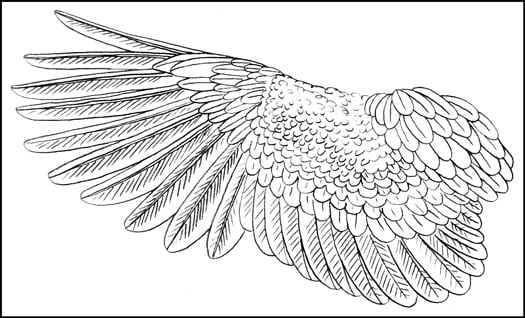
About This Article
This article can be found in the category:
- General (Drawing) ,
Source: https://www.dummies.com/article/academics-the-arts/art-architecture/drawing/general-drawing/drawing-the-furry-fluffy-and-feathered-199358/
0 Response to "Drawing of Tree With Feathers"
Post a Comment